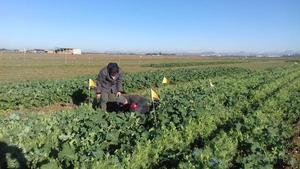
Biodiversified arable rotations in the Ebro valley region
Template for summary of activities of each case study to be added on the website
1-2 large view pictures of the site
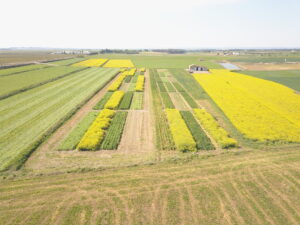
Aerial view of the intercropping on-farm experiment of the Spanish case-study in Sucs (Lleida). Plots size allowed the use of commercial machinery to assess the feasibility of intercropping in the area (Albert Alsina)
1-2 close-up pictures of crops

Durum wheat/pea intercrop in the on-farm experiment of the Spanish case-study in Sucs (Lleida) (spring 2021) (Daniel Plaza-Bonilla)

Pea/rapeseed intercrop in the on-farm experiment of the Spanish case-study in Sucs (Lleida) (spring 2023) (Daniel Plaza-Bonilla)

Durum wheat/fababean intercrop in the on-farm experiment of the Spanish case-study in Sucs (Lleida), a sub-plot without herbicides is located in the center of plot (spring 2023) (Louise Blanc)
1-2 pictures of group meetings/field visits (warning: if the face of people is visible, you need their consent!)
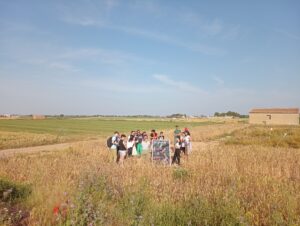
Field day of the Spanish case-study with Veterinary students. Louise Blanc, PhD student in the framework of Biodiversify providing main insights about crop diversification (Genís Simon-Miquel).
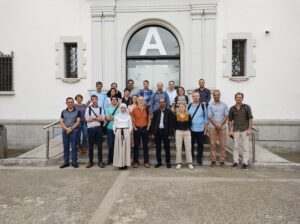
Mid-term project meeting held in Lleida (Spain) (ETSEAFiV-UdL).
Summary of co-design workshops results
In the Spanish case-study stakeholders established a winter cereal short rotation as the reference system and proposed the introduction of pea and/or rapeseed as sole crops in the rotation as diversification strategy. According to stakeholders, co-design that process would be accompanied by the modification of a range crop management practices aimed soil and water conservation and reduced fuel consumption such as conservation tillage, adopting precision agriculture techniques, and valorizing as much as possible available organic fertilizers such as pig slurry from livestock activities.
Summary of field work results
The Land Equivalent Ratio (LER) for grain yield was marginally higher than 1 in some of the intercrops tested in the scenario without N synthetic fertilizer. Biomass of intercropped legumes showed higher reliance on N derived from biological N fixation. Grain N content was similar for pea and chickpea cultivated as sole crops or intercropped with durum wheat. However, the proportion of nitrogen in the grain derived from biological fixation was significantly higher in the intercropped pea (73%) compared to sole pea (51%). Our preliminary results do not support the hypothesis of higher yields in intercropping compared to sole crops. Grain yield of intercropped species decreased without herbicides application compared with the herbicide treatment, with a higher decrease for legumes compared to durum wheat.
Summary of modelling (biophysical and/or economic) results
The long-term simulations of diversified crop rotations performed with the STICS model indicated increased wheat grain yield when preceded by pea and rapeseed (4 to 7% increase) compared to the reference rotation based on winter cereals. Rotation diversification improved protein productivity per unit of surface and had contrasting effects on energy productivity per unit of surface. While scenarios with pea or rapeseed one out of four years maintained it, introducing these crops each two years decreased. Crop rotation diversification would increase the reliance on pesticides, with higher TFI values than the reference system. As well, diversification scenarios would lead to a stabilization in soil organic carbon storage while the reference system would increase it. Regarding N losses, nitrate leaching and ammonia volatilization would increase in diversified scenarios compared to the reference system. That would be the result of asynchrony between crop N needs and N availability: reliance on organic fertilizers and decomposition of low C:N residues would explain this unexpected result. Finally, expenses decreased with diversified cropping systems, mainly linked to the lower use of mineral N fertilizer and the reduction in tillage intensity. Incomes increased in scenarios with pea or rapeseed introduced in the rotation one out of four years compared to the reference scenario, but decreased when introduced every two years. Profitability of all the diversified cropping systems was higher than in the reference one.
Final words
-
The UdL team greatly acknowledges the involvement of Ramon Pujol and family (Jolbertal SL, Sucs, Lleida) for their willingness to collaborate with the project.
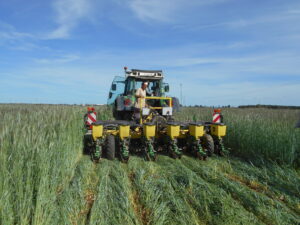
Ramon Pujol Jr and Sr (Jolbertal SL, Sucs, Lleida) (Daniel Plaza-Bonilla)
Links to relevant practical abstracts, relevant papers…. Produced in the project
-
https://www.sciencedirect.com/science/article/pii/S1161030121002203
-
Practical abstract sent to the consortium.
-
Dissemination article (under suscription): https://www.interempresas.net/FlipBooks/TE/295/106/
